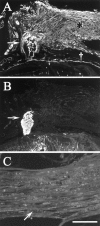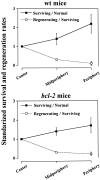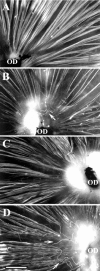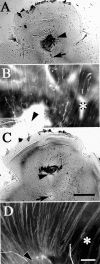Bcl-2 overexpression does not enhance in vivo axonal regeneration of retinal ganglion cells after peripheral nerve transplantation in adult mice
- PMID: 12040054
- PMCID: PMC6758825
- DOI: 10.1523/JNEUROSCI.22-11-04468.2002
Bcl-2 overexpression does not enhance in vivo axonal regeneration of retinal ganglion cells after peripheral nerve transplantation in adult mice
Abstract
Optic nerve (ON) injury in adult mammals causes retinal ganglion cell (RGC) death and subsequent visual loss. Recovery of vision requires both rescuing axotomized RGCs and inducing their axonal regeneration. Axotomized RGCs are significantly rescued by overexpression of bcl-2, an anti-apoptotic gene. However, whether bcl-2 affects axonal regeneration is controversial. In neonatal bcl-2 transgenic mice (bcl-2 mice), optic tract regeneration after tectal lesion was promoted (Chen et al., 1997), whereas ON regeneration after ON crush was not (Lodovichi et al., 2001). These conflicting results may be attributable to different environments between tectum and ON. We tested here whether bcl-2 overexpression enhances in vivo RGC axonal regeneration in adult mice through a permissive environment in the peripheral nerve (PN) graft. Four weeks after PN transplantation to the proximal ON stump, we assessed the number of surviving and regenerating RGCs by retrograde labeling. Although the survival rate in bcl-2 mice was significantly enhanced compared with that in wild-type (wt) mice, the regeneration rate was not enhanced. In both bcl-2 and wt mice, RT97 immunostaining of the PN-grafted retinas revealed some RGC axons regrowing intraretinally but repulsed at the optic disk. To circumvent this repulsive barrier, we directly transplanted the PN graft to the partially injured retina and compared regeneration rates between these mice. Here again the regeneration rate in bcl-2 mice did not exceed that in wt mice. These findings indicate that bcl-2 overexpression enhances survival but not axonal regeneration of adult RGCs even within a permissive environment.
Figures







References
-
- Bähr M. Live or let die: retinal ganglion cell death and survival during development and in the lesioned adult CNS. Trends Neurosci. 2000;23:483–490. - PubMed
-
- Bates CA, Becker CG, Miotke JA, Meyer RL. Expression of polysialylated NCAM but not L1 or N-cadherin by regenerating adult mouse optic fibers in vitro. Exp Neurol. 1999;155:128–139. - PubMed
-
- Cenni MC, Bonfanti L, Martinou J-C, Ratto GM, Strettoi E, Maffei L. Long-term survival of retinal ganglion cells following optic nerve section in adult bcl-2 transgenic mice. Eur J Neurosci. 1996;8:1735–1745. - PubMed
-
- Chen DF, Schneider GE, Martinou J-C, Tonegewa S. Bcl-2 promotes regeneration of severed axons in mammalian CNS. Nature. 1997;385:434–439. - PubMed
Publication types
MeSH terms
Substances
LinkOut - more resources
Full Text Sources
Miscellaneous
